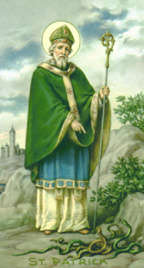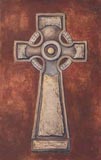|
The Legend of St PatrickThe legend of St Patrick is a symbolic version of his life as Patron Saint of Ireland and what his life means to the Irish people.
St Patrick legends are a blend of fact and fantasy. It's difficult to tell the difference sometimes. Some elements may be true. Without mention in his surviving writings (his "Confessio" and his letter to Coroticus), we just don't know for sure. But as with most legends, the legend of St Patrick is symbolic and inspirational for millions. From Slavery to SorrowThe legend of St Patrick begins with his return to the land of his captivity around 433 AD. It's likely he arrived at the banks of the Vantry River. Even though he immediately met with fierce resistance by the Druid Priests, he forged onward determined to fulfill his mission. He set out to find a friendlier audience, in the halls of his previous master in Dalriada. It would have been completely understandable for him to seek revenge for the years of servitude and cruelty he endured at the hands of Milchu. Instead, he gave witness to the blessings of Christ. Unfortunately, Milchu didn't want to hear Patrick's message. He knew Patrick was on his way to see him and intended to convert him to Christianity. Before Patrick arrived, Milchu set himself and all his possessions afire. In Milchu's mind, he was following an ancient custom and dying with honor. He chose to die and hang on to his ancient beliefs rather than hear what Patrick had to say. When Patrick found him, he was understandably devastated. He had intended to compensate Milchu for the financial loss his escape had caused. It would have been understandable for him to hold nothing but bitterness for Milchu. But in true Christian spirit, as the legend of St Patrick says, he cried in despair because all he wanted was a chance to save his soul. The Deer's Cry
On the way, he and his followers chanted the hymn best known as "Saint Patrick's Breastplate" or "The Lorica". They knew the Druid High Priests had planned to ambush them somewhere along their journey. As he and his followers continuously chanted, the men waiting in the bushes to kill all of them saw a doe followed by fawns. Needless to say, St Patrick and his prayer saved them all. Because of this part of the legend of St Patrick, this prayer is also sometimes called "The Deer's Cry". Showdown at the Hill of TaraIn honor of Easter, he made a large fire on the Hill of Slane closeby. By doing this, he was boldly defying the pagan custom to put out all the fires before a new one was lit at Tara. The Druid Priests at Tara saw the fire and quickly warned the King that if he didn't put it out inmmediately it would burn eternally. Patrick was then summoned to Tara to face the King. Once he arrived in Tara, the Druid Priests advising King Laoghaire challenged Patrick to demonstrate his powers. They engaged in a duel of sorts which Saint Patrick decidedly won. The Druid Priests conceded victory and the King, so impressed by Saint Patrick's powers, granted him permission to travel freely through Ireland fulfilling his missionary work. Symbol of the Holy TrinityThe wisdom of St Patrick's mission was to take ancient pagan Celtic ideas and beliefs and use them to explain the concepts of Christianity in such a way that the Druids and their followers would embrace Christ and the Trinity. Knowing that it was considered a sacred plant to them already, he plucked a shamrock right out of the ground he was standing upon. Then he held it up high so everyone could see, and proclaimed, "Do you not see how in this wildflower three leaves are united on one stalk, and will you then believe that there are indeed three persons and yet one God?" St Patrick had managed to explain the Trinity, the essence of Christian Doctrine, to the High King of Ireland using a simple shamrock. King Laoghaire was converted. The King and the Druid High Priests agreed to grant St Patrick the freedom to take his message anywhere and everywhere in Ireland. Not only had he converted the King, but also many of the Druid High Priests as well. Some even became Bishops themselves. The evolution of ancient Druid spirituality with this "new" religion, Christianity, laid a strong foundation for Celtic Christianity that has survived even to this day. Click here to read more about the legend of St Patrick and the shamrock. Banishing the SerpentsA big part of the legend of St Patrick is that he drove all the snakes out of Ireland forever. In this part of the legend of St Patrick, he filled the Emerald Isle with lush shamrock fields to keep the snakes from ever returning. People say that shamrocks would grow wherever St Patrick had preached. An old Irish blessing says, It is true that you won't find any snakes in Ireland. Believers in Irish folklore take this as proof that St Patrick indeed did banish all the serpents from the Emerald Isle. This part of the legend of St Patrick is validated to some by the fact that snakes are never seen in fields of shamrocks anywhere in the world, and that shamrocks can indeed be used as a remedy for snake venom. The question is whether or not they were ever there at all. Some scholars believe that there have never been snakes in Ireland. The more romantic folk believe St Patrick really did perform a Divine miracle and drove them out. Actually most people these days realize that this part of the legend of St Patrick is probably just a metaphor for the fact that he did indeed drive out the pagan beliefs and rituals, which are commonly associated with snakes. Many stories and legends of St Patrick's travels are told beautifully by Patrick Francis Cardinal Moran for the Catholic Encyclopedia, Volume XI. Click here to return to the TOP of the page The Legend of St Patrick and the Shamrock Saint Patrick: Patron Saint of Ireland Home | Blog | Search | Site Map | Link to Me | Request a Link |






